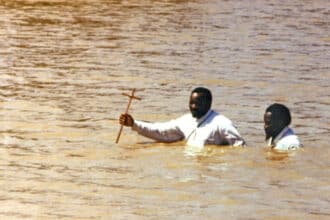A Christmas ‘Parcel’ aboard a Jozi train
In late December 1912, a few days before Christmas, a passenger train from Johannesburg arrived in Palapye carrying ‘a special package’ that would go on to shape the city of Francistown’s future.
According to Peter Matante, his grandparents, who resided in South Africa, travelled to Botswana every December to celebrate Christmas Day with relatives.
“That particular year, the relatives were told that my grandmother was on the passenger train and was bringing a parcel with her,” recalled Matante.
When the relatives arrived at the station, they were shocked to see his grandmother disembarking from the train with a huge baby bump. She was heavily pregnant.
“And on 25th December, my father Phillip ‘Parcel’ Matante was born. That is where the name ‘Parcel’ came from,” explains Peter.
On Wednesday morning, Matante’s memories were brought back to life courtesy of SupaNgwao Museum and the American Embassy.
The two organisations are collaborating on a project that intends to turn Francistown into a vibrant heritage and cultural hub, through retelling the city’s stories and recognising its iconic figures.
Aged 67, Matante died in 1979 and is buried in Riverside at one of the city’s historical gravesites.

The WENELA (Witwatersrand Native Labour Association) gravesite is home to 71 Malawian natives who perished in a plane crash. A total of 78 people died, including four Batswana and three crew members on that fateful day on 4th April, 1974.
According to the museum curator, Jefferey Matheakgomo, stories like the DC-4 crash, the gravesite and Matante’s legacy are some of the untold tales that could turn the second capital into an exciting heritage destination for tourists.
“Matante was an iconic figure, and we are simply honouring the contributions he made to the development of this country, and Francistown,” said Matheakgomo.
Spending most of his youth in South Africa, following his migration to the neighbouring country, the young Matante was forced to end his studies at St. Peter’s College following the death of his father, eventually getting a job as a clerk in a gold mine.
By 1942, Matante now 30, returned home to the then Bechuanaland Protectorate to serve in the African Pioneer Corps, where he rose through the ranks to become a Sergeant-Major, one of the few commoners to hold that rank.
He returned to SA after serving for five years, joining the African National Congress (ANC) in 1948 and marrying Mary Nini Matante.
However, with political tensions in South Africa escalating, Matante returned to Serowe in 1956, relocating to Francistown a year later to work as a store manager.
It wasn’t long before the political bug bit hard once again. In 1960, together with Kgalemang Tumediso Motsete and Motsamai Mpho, Matante founded the Botswana People’s Party (BPP).
His Pan Africanism politics meant he clashed regularly with the country’s minorities as he preached the “British must pack and go”.
His oratory skills at freedom squares earned him many admirers. It was no wonder that in the country’s first general elections in 1965, under his leadership the BPP won three Parliamentary seats to become the sole opposition party in the National Assembly.
One of his outrageous acts was walking out of the 1966 Independence negotiations in London after his call for new elections and a further review of the constitution were rejected.
Matante is credited with calling for the formation of the Botswana Defence Force (BDF) and having Pula and Thebe (BWP) introduced in 1976 as the country’s currency through his many robust and notorious debates in parliament.
He also advocated for the building of a bigger and better hospital for the northern part of Botswana, leading to the eventual construction of Nyangabgwe Referral Hospital in 1989.
In 2019, President Mokgweetsi Masisi renamed the Francistown International Airport after the legendary figure – a fitting tribute to a special soul.

The original airport was built in 1920 as a temporary airstrip servicing one flight fortnightly to and from Maun.
Today, the PG Matante International Airport connects Botswana with the SADC region and the rest of the world, and Matante’s legacy lives on as thousands ‘pack and go’ via the airport whose terminal was upgraded to the tune of P474 million in 2011.





